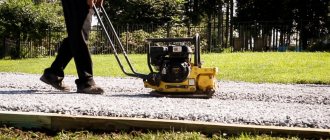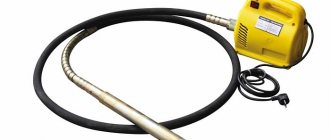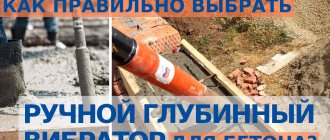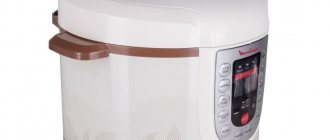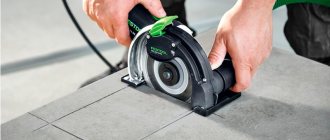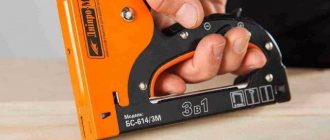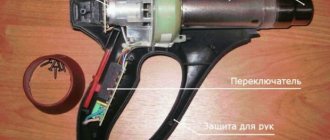Vibrating plate is equipment designed for tamping/compacting earth and bulk materials when performing construction and other types of work. It differs in the type of energy used, size, method of movement and other parameters. Below we will consider the purpose of such devices, talk about classification, provide recommendations for maintenance and consider other issues.
Purpose of vibrating plates
The main task of a vibrating plate is to compact the soil and prepare it for further construction work. Such equipment has found wide application in the following activities:
- creation of a unique landscape;
- construction of foundations for various objects;
- laying tiles;
- conducting communications;
- construction of roads, parking lots, roads for pedestrians;
- arrangement of sports grounds, etc.
The use of a vibrating plate is relevant when working in a relatively small area, not exceeding 1000 square meters. Unlike large-sized machines, for example, rollers, the use of such equipment allows you to save money, complete the assigned tasks and process even the most inconvenient areas.
Soil compaction by lowering the groundwater level.
Soil compaction by lowering groundwater levels
It is advisable to carry out
in weak soils
(see Table 1).
Groundwater
is lowered by
pumping water through wellpoints
From the wells
Water is continuously pumped out and the groundwater level is below the bottom of the pit, which allows
construction to be carried out in a drained pit
.
If there is a need for deep water reduction using the pit method of work, wellpoints
installed in several tiers.
Scheme of soil compaction
by lowering groundwater using wellpoints in two tiers in foundation pits.
You can read an article about prefabricated strip foundations here
linear, poorly filtered soils
As a rule, they do not “give” water well, so when compacting them they resort to electroosmosis.
two mutually perpendicular networks of electrodes are immersed into the ground along the contour of the pit (Fig. 13, item 1).
and pass electric current through them (Fig. 13, pos. M).
Wellpoints with a collector
(Fig. 13, item 2) form
a network of electrodes - cathodes
.
The anodes
are
rods
(Fig. 13, item 6), immersed in the ground from the inside of the pit at a distance of approximately
0.8 m
from the wellpoints.
Scheme for draining groundwater from foundation pits
using electroosmosis or, you can use the method: penetrating waterproofing
When electric current is passed through a network, steam water
is concentrated
at the cathodes
and pumped out by a pump (Fig. 13, item 4), which allows the development of a pit under normal,
non-watered conditions
.
Operating principle
Structurally, a vibrating plate consists of a group of components: a supporting part, a main body (which creates vibration), a motor with different types of power, and controls. The lower part of the device, which is in contact with the surface of the earth, is the sole or slab. Its function is to create pressure on the soil and increase its density through vibration.
Important
The greater the mass and dimensions of the base, the higher the efficiency of the vibrating plate. To improve the characteristics of the sole, thick metal of 8 mm or more is used.
Most often, a steel or cast iron sole is used, reinforced by creating a ribbed surface. In addition, the base of the vibrating plate is used to fix the drive and other mechanisms.
The support part has curved edges at the front and back, which simplifies the movement of equipment and prevents the top layer of earth or building materials from being caught. When compacting tiles, a rubber or polyurethane gasket is used to prevent mechanical damage. As a rule, it comes included.
To create vibration, a so-called eccentric/imbalance shaft is used. It receives vibrations from the motor through a centrifugal clutch and is then transmitted to the base. As a result, the treated area experiences pressure from the weight of the product and additionally takes on strong vibrations. Depending on the model, vibration frequency and force may vary.
The vibrator is large in size, because the efficiency of the equipment directly depends on this. It can be with one or two shafts. The first is used for straight sections, and the second is distinguished by its ability to move forward and backward.
Constructive methods of artificial improvement of foundations.
As noted earlier (see Fig. 4), constructive methods of artificially improving foundations are implemented by installing soil cushions, embankments, sheet piling and soil reinforcement.
Method 1. Ground pads.
Ground pillows
, according to
SNiP2.02.01-83
, it is RECOMMENDED to be made from
sand, gravel, crushed stone
(it is possible to use slag and mineral waste from various industries) with complete or partial replacement (in plan and in depth) of soils with unsatisfactory properties.
READ ALSO: Fit bolts: design features and scope of use
There is soil in the volume of the cushion
is in a more complex state than in a layered base.
This is due to the fact that along the perimeter of the cushion there is weak soil, which is significantly compacted in the horizontal direction. Therefore, to ensure stability, the calculated resistance of the foundation soils to the cushion is RECOMMENDED to be limited to values not exceeding the values specified in Appendix 3 of SNiP 2.02.01-83
.
ATTENTION! When constructing, for example, a sand cushion
angle a ranges from
30...45°
. They are NOT RECOMMENDED for use in case of possible leaching (the phenomenon of suffusion) of sand from the body of the pillow, as well as when laying a foundation above the calculated freezing depth, since heaving of the soil in the body of the pillow is possible when it freezes.
Method 2. Loading the embankment.
The loading of the embankment, which is used to prevent the uplift of soft soil from under the structure
.
The loading device within the limits of a possible bulging prism ensures the stability of objects erected on embankments
.
Method 3. Sheet piling base.
Sheet piling foundations are often used in the construction of single foundations
(bridge piers, lighthouse foundations, etc.)
with a circular outline in plan
.
The tongue
(Fig. 7, pos. 3) is driven along the entire perimeter
of the foundation
(Fig. 7, pos. 5) in order to avoid weak soil bulging out from under the foundation.
If there is a weak layer of soil (Fig. 7, item 2) at the base, sheet piling
they are hammered in such a way that it (
the sheet pile
) is buried in strong soils with
the top of it embedded in the foundation
(Fig. 7, item 5), under which a drainage sand bedding is arranged (Fig. 7, item 4).
Method 4. Soil reinforcement.
Soil reinforcement is used to increase the stability of the foundation of embankments
, as well as to significantly increase the stability
of retaining walls
. In this case, as the soil is backfilled, reinforcing bars (or technical non-rotting fabric) are placed in it, which come, for example, from a retaining wall and extend beyond the collapse prism,
Sometimes, according to SNiP 2.02.01-83
,
reinforcement of bulk soil
is carried out by introducing
special films, meshes and other materials
.
Classification of vibrating plates
Before you buy a vibrating plate, you need to decide on its type. This is important, because the models on the market differ in many characteristics, including the type of motor, movement characteristics and other parameters. For convenience, we present the main criteria.
By energy use
The first thing you should pay attention to when purchasing is the operating features of the engine. So, all vibrating plates are conditionally divided into the following categories.
Electrical
They have low power, but are environmentally friendly and quiet. They have a higher price. They operate from a household network in the immediate vicinity of the outlet. Most often used for landscaping work near a house/dacha, for compacting tiles. Electric vibratory plates can weigh up to 300 kg and provide compaction up to 0.4 m deep. When carrying out work at a distance from an outlet, it is recommended to buy a generator.
Pros:
- no exhaust;
- quiet operation;
- no additional fuel costs.
Minuses:
- low power;
- dependence on sockets.
An example is Vibromash VU-11-75. This device has a power of 550 W, a sole size of 80x50 cm, a compaction depth of 30 cm and a force volume of 11.3 kN. It weighs 80 kg, and its purchase costs about 41,000 rubles.
Gasoline
An autonomous solution is a gasoline vibrating plate, which has a special fuel tank and does not depend on the household network. Today it is the most popular option due to ease of maintenance and use. There is a large selection of devices with different types of motors on sale.
Such devices are distinguished by their reliability, efficiency, and dust protection. Produced by many manufacturers in Germany, China, Russia, and Japan. They are considered an ideal solution for processing large surfaces; they can easily cope with compacting gravel or crushed stone.
Pros:
- work autonomy;
- Possibility of use on large surfaces;
- ability to perform complex tasks;
- a large assortment;
- reliability.
Minuses:
- the need to buy gasoline;
- the presence of exhaust, which creates difficulties when working in enclosed spaces.
As an example, let's highlight the Zitrek z3k90 model. The device has a motor with a power of 4.8 kW or 6.5 “horses”. The dimensions of the sole are 54x42 cm, and the compaction depth is up to 0.3 m. The magnitude of the vibration force is 13 kN, and the total weight is 90 kg. The cost of such a device is about 36,000 rubles.
Diesel
When renting vibrating plates for professional purposes, devices with a diesel unit are often used. Such models have the longest service life (almost twice as long as gasoline), but the cost is higher. Vibrating plates with diesel engines can easily cope with increased loads and are often used by construction / road / utility services.
Pros:
- increased level of reliability;
- ability to withstand any load;
- big choice;
- Possibility of professional use.
Minuses:
- high price;
- difficulty of maintenance;
- presence of exhaust.
As an example, let’s take a Masalta MS330-1S vibrating plate with a 9-horsepower diesel engine. The model is capable of compacting soil by 90 cm, has a weight of 355 kg and a slab size of 89x67 cm. Among the features are the presence of reverse and vibration of 62.5 Hz with a centrifugal force of 38 kN. Price - about 220,000 rubles.
Hydraulic
New type of vibrating plates designed to solve complex problems. They are an ideal option for filling and compacting recesses for cables and pipes, preparing the surface for laying road surfaces, etc. The drive operates on a hydraulic principle, which increases the maneuverability of the models and improves their maneuverability on difficult soils. The presence of a hydraulic drive simplifies the control of equipment that can be used for a long time without interruption.
Pros:
- versatility of use;
- reliability;
- good maneuverability on different soils;
- possibility of long-term operation;
- autonomy.
Minuses:
- high price;
- the need to use a water tank.
Example -TSS-CP-350 - reversible vibrating plate with a power of 9.4 kW, compaction depth of 0.9 m, reverse and a plate of 86x48.5 cm. The price of the vibrating plate is about 400,000 rubles.
By mode of transportation
When choosing a vibrating plate, you must also take into account the method of movement. The following options are possible here:
- Trailed. Such devices cannot move independently, so they require the use of additional equipment: a tractor, truck, etc.
- Mounted. Most often they play the role of additional equipment for excavators and other equipment.
- Removable. Move to the required areas using lifting mechanisms.
- Self-propelled. The most popular option. Such machines are independent and controlled by an operator. They are conventionally divided into two categories - with and without reverse. The former can move in both directions, while the latter need to turn around.
By weight
When choosing vibrating plates, it is necessary to take into account the weight classification. The following options are possible here:
- The lightest - up to 75 kg. They are used to prepare soil for laying tiles on paths and when carrying out landscaping activities. Compact the soil to a depth of 15 cm.
- Lightweight - from 70 to 90 kg. The best option for solving most problems, because this technique provides compaction to a depth of 20-25 cm. It is used when repairing holes and laying tiles.
- Medium - from 90 to 140 kg. They easily compact soil to a depth of 30 cm. Suitable for foundation work and road construction.
- Heavy - over 140 kg. They are used to solve professional problems during the construction process. Necessary when compacting building materials.
Safety precautions for work
When compacting soil with a pneumatic primer and using it for other materials, you should first go through the safety regulations.
Of the recommendations that already exist, remember the following:
- For safe operation, the operator must cover his body and face with personal protective equipment, namely headphones, glasses, hard hats, durable clothing and shoes.
- If work will be carried out on a small hill, then the operator and other workers must be above the device. The work should be done from top to bottom.
If for some reason the vibrating plate encounters an obstacle, you should immediately turn it off. After this, remove the obstacle, and the tool should be inspected to ensure that it does not have any malfunctions.
- Do not leave the device while it is running unattended. When working, the master must be behind the device and constantly monitor it, moving nearby.
- It is prohibited to operate the vibrating plate in rooms or areas where there are fire hazards or flammable objects nearby.
If work is carried out on the edge of a trench, ravine or pit, then a person can be at the minimum permissible distance from the cliff, but not closer.- To further speed up the device, do not apply force; this is strictly prohibited.
- To rotate the device, you should use only one hand.
- Before work begins, all equipment should be inspected in advance and ensure that there is no damage to it. If there are any external defects, they must be removed in advance.
- To prevent injury, keep your feet and hands a short distance from the working surface of the device.
- If for some reason the device falls on the block, then first turn it off. Only after this can you begin to lift it and put it into working condition.
- It is strictly prohibited to perform work under the influence of drugs, alcohol or psychotropic intoxication.
- You cannot work without rest for a long time. After you have been tamping for 40 minutes, you should take a 10-minute break to relieve the equipment and workers.
Please note that the higher the center of gravity of the device, the easier it is to tip over. In addition, the master should be careful when working with equipment that has a small support area.
Work especially carefully with a vibrating plate that has a soft start button, since if the work is done in a confined space, then it will be much safer for a person to use remote-controlled models. Naturally, such devices are more expensive, but they fully justify their cost. Compaction with a vibrating plate helps to cope with any tasks that involve compacting bulk materials. To get a high-quality result, you should take into account the characteristics of specific surfaces, and also calculate the appropriate thickness for the layer. The main attention should be paid to safety precautions. Failure to follow these basic rules can result in serious injury and tool failure.
Maintenance and care of vibrating plates
Regardless of the type, equipment that performs compaction to compact soil requires proper maintenance. Let's highlight the main recommendations:
- At the preparation stage, it is necessary to check the oil and top it up, add fuel (gasoline, diesel fuel). When choosing technical fluids, you must follow the manufacturer's recommendations. In the future, the lubrication should be checked every day.
- New equipment requires running-in for five hours without increased load, followed by system maintenance and oil changes.
- Filters need to be replaced periodically as foreign elements get into them and clog the product. Failure to do this may result in damage.
- The chassis must be periodically cleaned to remove traces of dirt and tar. You can use gasoline/kerosene for this.
- If you have a water tank, you should periodically check it for leaks and damage.
Also during the service process, it is necessary to check parts for damage, monitor the operation of control elements, etc. Detailed instructions for service are provided by the manufacturer.
Compaction of soils by loading
Compaction of soils by loading
with the installation of
vertical drains
is carried out with
weak water-saturated silts, clays and loams
, which are in a fluid and fluid-plastic state, as well as
peats
.
The listed soil deposits have low water permeability.
embankment
plays the role of loading , and
vertical drains
accelerate the compaction process.
READ ALSO: Types of paving slabs
Currently, in addition to sand drains, drains made of special porous cardboard, as well as plastic tapes in a paper casing, have been used.
It was previously noted that with the increase in the volume and pace of construction, and the increase in requirements for soil stability, the solution of such a complex problem as the purposeful artificial change of the foundations of buildings and structures in the direction necessary for humans acquires special importance.
Vibrating rammer as a special case of vibrating plate
Vibrating rammer is an alternative option that involves the use of hand tools. This method is relevant when it is necessary to process small areas, when the use of complex equipment is not necessary. Its features:
- Small sizes.
- The need to keep equipment in an upright position.
- Ability to work in hard-to-reach places due to its small dimensions.
- No need to clear space.
- Compact and easy to store even in a small room.
A vibratory rammer is suitable for compacting a small area and is used to solve some small problems. An example is AvantRM-90 D. This is an electric device for vibratory ramming with an impact force of 9 kN, a ramming depth of up to 40 cm, a base size of 30x30 cm and a weight of 82 kg.

